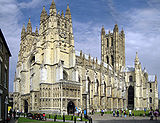- Nonjuring schism
-
The nonjuring schism was a split in the Church of England in the aftermath of the Glorious Revolution of 1688, over whether William of Orange and his wife Mary could legally be recognised as King and Queen of England.
The word 'nonjuring' means 'not swearing [an oath]', from the Latin word iuro or juro meaning 'to swear an oath'.
Many of the Anglican clergy felt legally bound by their previous oaths of allegiance to James II and, though they could accept William as Regent, they could not accept him as king. It was not necessarily a split on matters of religious doctrine, but more of a political issue and a matter of conscience, though most of the nonjurors were high church Anglicans.[1] Thus, latitudinarian Anglicans were handed control of the Church of England. The nonjurors thus supported Jacobitism, although they generally did not actively support the Jacobite rebellions in 1715 or 1745.
Contents
The nonjuring bishops
Five of the Seven Bishops who had petitioned James against the Declaration of Indulgence nonetheless became nonjurors, along with four other bishops. The nine nonjuring English bishops were:
- William Sancroft* (Archbishop of Canterbury)
- Thomas Ken* (Bishop of Bath and Wells)
- John Lake* (Bishop of Chichester)
- Francis Turner* (Bishop of Ely)
- Thomas White* (Bishop of Peterborough)
- Thomas Cartwright (Bishop of Chester)
- Robert Frampton (Bishop of Gloucester)
- William Lloyd (Bishop of Norwich)
- William Thomas (Bishop of Worcester)
* Among the Seven Bishops.
These nine nonjuring bishops were joined by about 400 other Anglican clergy,[2] a substantial majority of the bishops in Scotland and one bishop in Ireland. In February 1690, the six surviving nonjuring English bishops were deprived of their sees and deposed (Thomas, Cartwright and Lake had already died). In Scotland the Episcopal Church was disestablished and Presbyterianism reintroduced. When the vacant sees were filled, some refused to recognise the new bishops and the nonjurors appointed their own bishops. In 1694, George Hickes (Dean of Worcester) was consecrated nonjuring bishop of Thetford and Thomas Wagstaffe was consecrated nonjuring bishop of Ipswich.
Wagstaffe died in 1712 and Hickes remained the only surviving nonjuring bishop; however he himself consecrated several successors. The nonjurors themselves split about 1717 over the issue of whether to introduce modifications in the Book of Common Prayer. One party, the usagers, led by Jeremy Collier and Thomas Brett, supported the restoration of four allegedly apostolic usages to the communion service. These included the mixed chalice, the prayers of epiklesis and invocation and prayers for the dead. The non-usagers, led by Charles Leslie and Nathaniel Spinckes, opposed any change to the established liturgy. The dispute was agitated in several dozen pamphlets. The rift was repaired in 1732. Some of the more prominent English nonjurors included Charles Leslie, George Hickes, Henry Dodwell, Francis Cherry, Robert Nelson, Nathaniel Spinckes, Jeremy Collier, Thomas Brett, Thomas Deacon, Roger Laurence, Archibald Campbell, Richard Rawlinson, Thomas Carte, Hilkiah Bedford, John Blackburne, Thomas Bowdler, Laurence Howell, William Law and Richard Russell.
Resolution
The nonjuring clergy and congregations gradually declined throughout the 18th century, as Jacobitism itself largely disappeared after the Second Jacobite rebellion of 1745. The schism was largely ended in 1788, when Charles Edward Stuart died in exile. Unwilling to recognise his heir, his brother Henry Benedict Stuart, who was a cardinal in the Roman Catholic Church, the Scottish Episcopal Church elected to recognise the House of Hanover and offer allegiance to George III. Still, some lines of succession of nonjuring bishops were maintained until the end of the century. The nonjurors would have an influence on John Henry Newman and other Tractarians in the early and mid nineteenth century.
References
- ^ Ashley, Maurice. Glorious Revolution of 1688. page 255.
- ^ "Non-Jurors". Catholic Encyclopedia. New York: Robert Appleton Company. 1913. http://www.newadvent.org/cathen/11099a.htm.
- Broxap, Henry (1924) The later Non-jurors, Cambridge University Press, 360 p.
External links
- Documents on the Nonjurors from Project Canterbury
- "Non-Jurors". Catholic Encyclopedia. New York: Robert Appleton Company. 1913. http://www.newadvent.org/cathen/11099a.htm.
- http://www.jacobite.ca/essays/nonjurors.htm
Categories:- Anglicanism
- History of the Church of England
- History of the British Isles
- Schisms in Christianity
- Non-jurors of the Glorious Revolution
- Jacobitism
Wikimedia Foundation. 2010.

